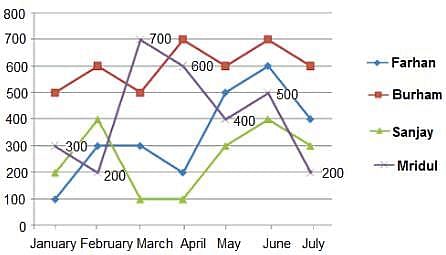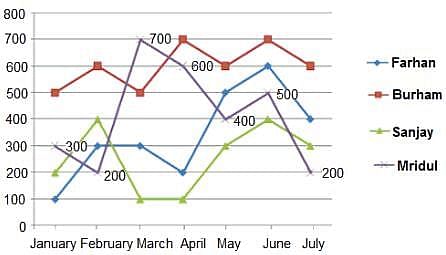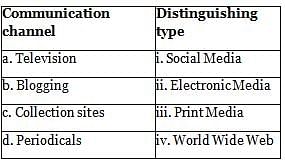UGC NET Paper 1 Practice Test - 8 - UGC NET MCQ
30 Questions MCQ Test - UGC NET Paper 1 Practice Test - 8
Directions: Study the given information and answer the following question.
The line graph shows the incentive points earned by four salespersons in different months of 2017.

Q. Which salesperson(s) earned the second-highest points during the given period?
The line graph shows the incentive points earned by four salespersons in different months of 2017.

Directions: Study the given information and answer the following question.
The line graph shows the incentive points earned by four salespersons in different months of 2017.

Q. What is the difference between the average number of points earned in January and that earned in May for all four salespersons together?
The line graph shows the incentive points earned by four salespersons in different months of 2017.

| 1 Crore+ students have signed up on EduRev. Have you? Download the App |
Which of the following is not a type of Research Method?
How can the objectivity of the research be enhanced?
Which of the following is responsible for uniformity in the curriculum at a higher level in India?
The term 'phenomenology' is associated with the process of
Which of the following is a type of malware intentionally inserted into a software system that will set off a malicious function when specified conditions are met?
Direction: This question has an assertion (A) and a reason (R). Find out how (A) and (R) are related.
Assertion (A): People population control measures do not necessarily help in checking environmental degradation.
Reason (R): The relationship between population growth and environmental degradation is rather complex.
Choose the correct answer from the following:
Which one of the following is considered a sign of motivated teaching?
The South Asia University is situated in the city of
If you get an opportunity to teach a visually challenged student along with normal students, what type of treatment would you like to give him in the class?
Direction: Read the following passage carefully and answer the question.
If India has to develop her internal strengths, the nation has to focus on the technological imperatives, keeping in mind three dynamic dimensions: the people, the overall economy and the strategic interests. These technological imperatives also take into account a ‘fourth’ dimension, time, an offshoot of modern-day dynamism in business, trade, and technology that leads to continually shifting targets. We believe that technological strengths are especially crucial in dealing with this fourth dimension underlying continuous change in the aspirations of the people, the economy in the global context, and the strategic interests. The progress of technology lies at the heart of human history. Technological strengths are the key to creating more productive employment in an increasingly competitive market place and to continually upgrade human skills. Without a pervasive use of technologies, we cannot achieve the overall development of our people in the years to come. The direct linkages of technology to the nation’s strategic strengths are becoming more and more clear, especially since the 1990s. India’s own strength in a number of core areas still puts it in a position of reasonable strength in the geopolitical context. Any nation aspiring to become a developed one needs to have strengths in various strategic technologies and also the ability to continually upgrade them through its own creative strengths. For people-oriented actions as well, whether for the creation of large scale productive employment or for ensuring nutritional and health security for people or for better living conditions, technology is the only vital input. The absence of greater technological impetus could lead to lower productivity and wastage of precious natural resources. Activities with low productivity or low-value addition, in the final analysis, hurt the poorest most. The technological imperatives to lift our people to a new life, and to life, they are entitled to be important. India, aspiring to become a major economic power in terms of trade and increase in GDP, cannot succeed on the strength of turnkey projects designed and built abroad or only through large-scale imports of plant machinery, equipment and know-how. Even while being alive to the short-term realities, medium and long-term strategies to develop core technological strengths within our industry are vital for envisioning a developed India.
Q. According to the above passage, which of the following are indicative of the fourth dimension?
1) Aspirations of people
2) Modern day dynamism
3) Economy in the global context
4) Strategic interests
Code:
Direction: Read the following passage carefully and answer the question.
If India has to develop her internal strengths, the nation has to focus on the technological imperatives, keeping in mind three dynamic dimensions: the people, the overall economy and the strategic interests. These technological imperatives also take into account a ‘fourth’ dimension, time, an offshoot of modern-day dynamism in business, trade, and technology that leads to continually shifting targets. We believe that technological strengths are especially crucial in dealing with this fourth dimension underlying continuous change in the aspirations of the people, the economy in the global context, and the strategic interests. The progress of technology lies at the heart of human history. Technological strengths are the key to creating more productive employment in an increasingly competitive market place and to continually upgrade human skills. Without a pervasive use of technologies, we cannot achieve the overall development of our people in the years to come. The direct linkages of technology to the nation’s strategic strengths are becoming more and more clear, especially since the 1990s. India’s own strength in a number of core areas still puts it in a position of reasonable strength in the geopolitical context. Any nation aspiring to become a developed one needs to have strengths in various strategic technologies and also the ability to continually upgrade them through its own creative strengths. For people-oriented actions as well, whether for the creation of large scale productive employment or for ensuring nutritional and health security for people or for better living conditions, technology is the only vital input. The absence of greater technological impetus could lead to lower productivity and wastage of precious natural resources. Activities with low productivity or low-value addition, in the final analysis, hurt the poorest most. The technological imperatives to lift our people to a new life, and to life, they are entitled to be important. India, aspiring to become a major economic power in terms of trade and increase in GDP, cannot succeed on the strength of turnkey projects designed and built abroad or only through large-scale imports of plant machinery, equipment and know-how. Even while being alive to the short-term realities, medium and long-term strategies to develop core technological strengths within our industry are vital for envisioning a developed India.
Q. More productive employment demands :
Direction: Read the following passage carefully and answer the question.
If India has to develop her internal strengths, the nation has to focus on the technological imperatives, keeping in mind three dynamic dimensions: the people, the overall economy and the strategic interests. These technological imperatives also take into account a ‘fourth’ dimension, time, an offshoot of modern-day dynamism in business, trade, and technology that leads to continually shifting targets. We believe that technological strengths are especially crucial in dealing with this fourth dimension underlying continuous change in the aspirations of the people, the economy in the global context, and the strategic interests. The progress of technology lies at the heart of human history. Technological strengths are the key to creating more productive employment in an increasingly competitive market place and to continually upgrade human skills. Without a pervasive use of technologies, we cannot achieve the overall development of our people in the years to come. The direct linkages of technology to the nation’s strategic strengths are becoming more and more clear, especially since the 1990s. India’s own strength in a number of core areas still puts it in a position of reasonable strength in the geopolitical context. Any nation aspiring to become a developed one needs to have strengths in various strategic technologies and also the ability to continually upgrade them through its own creative strengths. For people-oriented actions as well, whether for the creation of large scale productive employment or for ensuring nutritional and health security for people or for better living conditions, technology is the only vital input. The absence of greater technological impetus could lead to lower productivity and wastage of precious natural resources. Activities with low productivity or low-value addition, in the final analysis, hurt the poorest most. The technological imperatives to lift our people to a new life, and to life, they are entitled to be important. India, aspiring to become a major economic power in terms of trade and increase in GDP, cannot succeed on the strength of turnkey projects designed and built abroad or only through large-scale imports of plant machinery, equipment and know-how. Even while being alive to the short-term realities, medium and long-term strategies to develop core technological strengths within our industry are vital for envisioning a developed India.
Q.Envisioning a developed India requires :
Directions: Read the following passage and answer the given question.
The decisive shift in British Policy really came about under mass pressure in the autumn and winter of 1945 to 46 – the months which Perderel Moon while editing Wavell’s Journal has perceptively described as ‘The Edge of a Volcano’. Very foolishly, the British initially decided to hold public trials of several hundreds of the 20,000 I.N.A. prisoners (as well as dismissing from service and detaining without trial no less than 7,000). They compounded the folly by holding the first trial in the Red Fort, Delhi in November 1945, and putting on the dock together a Hindu, a Muslim and a Sikh (P.K. Sehgal, Shah Nawaz, Gurbaksh Singh Dhillon). Bhulabhai Desai, Tejbahadur Sapru and Nehru appeared for the defence (the latter putting on his barrister’s gown after 25 years), and the Muslim League also joined the countrywide protest. On 20 November, an Intelligence Bureau note admitted that “there has seldom been a matter which has attracted so much Indian public interest and, it is safe to say, sympathy... this particular brand of sympathy cuts across communal barriers." A journalist (B. Shiva Rao) visiting the Red Fort prisoners on the same day reported that "There is not the slightest feeling among them of Hindu and Muslim. A majority of the men now awaiting trial in the Red Fort is Muslim. Some of these men are bitter that Mr Jinnah is keeping alive a controversy about Pakistan." The British became extremely nervous about the I.N.A. spirit spreading to the Indian Army and, in January, the Punjab Governor reported that a Lahore reception for released I.N.A. prisoners had been attended by Indian soldiers in uniform.
Q. Which heading is most appropriate for the given passage?
Directions: Read the following passage and answer the given question.
The decisive shift in British Policy really came about under mass pressure in the autumn and winter of 1945 to 46 – the months which Perderel Moon while editing Wavell’s Journal has perceptively described as ‘The Edge of a Volcano’. Very foolishly, the British initially decided to hold public trials of several hundreds of the 20,000 I.N.A. prisoners (as well as dismissing from service and detaining without trial no less than 7,000). They compounded the folly by holding the first trial in the Red Fort, Delhi in November 1945, and putting on the dock together a Hindu, a Muslim and a Sikh (P.K. Sehgal, Shah Nawaz, Gurbaksh Singh Dhillon). Bhulabhai Desai, Tejbahadur Sapru and Nehru appeared for the defence (the latter putting on his barrister’s gown after 25 years), and the Muslim League also joined the countrywide protest. On 20 November, an Intelligence Bureau note admitted that “there has seldom been a matter which has attracted so much Indian public interest and, it is safe to say, sympathy... this particular brand of sympathy cuts across communal barriers." A journalist (B. Shiva Rao) visiting the Red Fort prisoners on the same day reported that "There is not the slightest feeling among them of Hindu and Muslim. A majority of the men now awaiting trial in the Red Fort is Muslim. Some of these men are bitter that Mr Jinnah is keeping alive a controversy about Pakistan." The British became extremely nervous about the I.N.A. spirit spreading to the Indian Army and, in January, the Punjab Governor reported that a Lahore reception for released I.N.A. prisoners had been attended by Indian soldiers in uniform.
Q. I.N.A. stands for
Directions: Read the following passage and answer the given question.
The decisive shift in British Policy really came about under mass pressure in the autumn and winter of 1945 to 46 – the months which Perderel Moon while editing Wavell’s Journal has perceptively described as ‘The Edge of a Volcano’. Very foolishly, the British initially decided to hold public trials of several hundreds of the 20,000 I.N.A. prisoners (as well as dismissing from service and detaining without trial no less than 7,000). They compounded the folly by holding the first trial in the Red Fort, Delhi in November 1945, and putting on the dock together a Hindu, a Muslim and a Sikh (P.K. Sehgal, Shah Nawaz, Gurbaksh Singh Dhillon). Bhulabhai Desai, Tejbahadur Sapru and Nehru appeared for the defence (the latter putting on his barrister’s gown after 25 years), and the Muslim League also joined the countrywide protest. On 20 November, an Intelligence Bureau note admitted that “there has seldom been a matter which has attracted so much Indian public interest and, it is safe to say, sympathy... this particular brand of sympathy cuts across communal barriers." A journalist (B. Shiva Rao) visiting the Red Fort prisoners on the same day reported that "There is not the slightest feeling among them of Hindu and Muslim. A majority of the men now awaiting trial in the Red Fort is Muslim. Some of these men are bitter that Mr Jinnah is keeping alive a controversy about Pakistan." The British became extremely nervous about the I.N.A. spirit spreading to the Indian Army and, in January, the Punjab Governor reported that a Lahore reception for released I.N.A. prisoners had been attended by Indian soldiers in uniform.
Q. The sympathy of Indian soldiers in uniform with the released I.N.A. prisoners at Lahore indicates
Which of the following features is included in nonverbal communication?
Select from the code to indicate your answer
a) Appearance
b) Body language
c) Sound
d) Report
e) Job description
TEQIP (Technical Education Quality Improvement Programme) was launched by MHRD in which of the following years?
Given below are two statements:
Statement (I): Lecture-cum-Demonstration method can be used by the teachers for better results.
Statement (II): The project method is helpful in bringing out the creative and investigating aspect of the child.
In the light of the above statements, choose the most appropriate answer from the options given below:
The science of communication and control is known as
Match List I with List II:

Choose the correct answer from the options given below:
Directions: To answer the question, study carefully the following arrangement of symbols, digits and letters.
* B 3 9 N ? 5 2 Z I E $ # 9 2 E ^ D @ 6 8 % W Q J I
If all the letters are deleted from the above arrangement, then which of the following will be 5th element to the left of 4th element from right?
The objective of exploring the existing literature should be to identify which of the following issues?
A. What is already known about this area?
B. What concepts and theories are relevant to this area?
C. How to get funding for the research?
D. What are the significant controversies in this area?
E. Are there any inconsistencies in the findings of this area?
Choose the correct answer from the options given below:
If the statement 'all students are intelligent' is true, then which of the following statements is/are false?
(i) No students are intelligent.
(ii) Some students are intelligent.
(iii) Some students are not intelligent.
Match the following communication channels with their distinguishing type:

Choose the correct option from those given below:
If MOZART = 30 and PICASSO = 35, then EMBRANDT = _____.



















